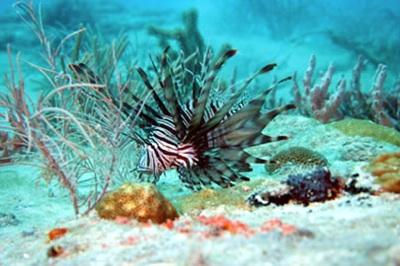Non-native lionfish, a venomous fish that poses problems for marine life and humans, seem to be making inroads into the waters of Biscayne National Park, according to park officials.
Though elegant in appearance with its waving spines, the Indo-Pacific lionfish has a voracious appetite and can out-compete the native snapper and grouper fisheries that are both commercially and ecologically important not just in the park, but throughout the Caribbean.
It's been thought that the species arrived in the waters of Biscayne Bay back in 1992 when Hurricane Andrew swept through the region and someone accidentally released several lionfish into the bay.
In June 2009, Biscayne National Park resource managers followed up on a reported sighting of a lionfish from a shipwreck within the park and were able to successfully remove that adult lionfish. Over the next 11 months lionfish sightings were sporadic and uncommon, according to park officials. But now, they say, it has become "clear that Biscayne National Park, along with many other parks and areas in south Florida and the Caribbean, is being invaded by the Indo-Pacific lionfish."
During the last two weeks, resource managers at Biscayne have observed (and in most cases removed) more than 40 lionfish from locations all over the park. Lionfish are being observed in and collected from shallow water seagrass, small shipwrecks in Biscayne Bay, beneath dock pilings, and from oceanside reef, wreck and hardbottom habitats, the park reports. As many as 17 lionfish have been removed from a single site in one day. The occurrence of visitor-reported sightings is also increasing in frequency.
All individuals observed and/or captured during these most recent efforts are very small, measuring between six and 12 centimeters. The small size indicates a successful recruitment from upstream spawning and suggests that Biscayne is in the early stages of the invasion, according to park officials. While total eradication of the lionfish is an unlikely outcome, resource managers are hoping to remove as many individuals as possible to keep the lionfish population in the park at a manageable size and to prevent these new recruits from becoming voracious reef predators as they grow to adult size.
Biscayne National Park’s lionfish management plan outlines the protocol for assessing and removing this exotic species. In addition, park managers are increasing outreach efforts (e.g. distributing flyers at local marinas and posting information on the park website) to educate the public about the increasing lionfish problem. Park managers are encouraging divers and anglers to use caution when engaging in activities that could result in an encounter with a lionfish.
There are no regulations on the harvest of lionfish, and as long as care is taken when filleting the fish, lionfish makes for a tasty meal, they say. Divers and anglers who do not wish to collect lionfish on their own are encouraged to report the details of their sightings to park managers, who can then visit the site and remove the lionfish.
Once introduced, lionfish can rapidly become an established species. The introduced lionfish poses potential problems for both the environment and humans. They are voracious predators that appear to compete for food resources of the already depleted, commercially and ecologically important snapper-grouper fishery. Furthermore, they have few natural predators in the Atlantic Ocean and studies show that Atlantic predators avoid lionfish. Introduced lionfish are not timid and readily approach divers and snorkelers, and their venomous spines can sting park users and can cause intense pain, swelling, headache, nausea, paralysis, and convulsions.


 Support Essential Coverage of Essential Places
Support Essential Coverage of Essential Places






